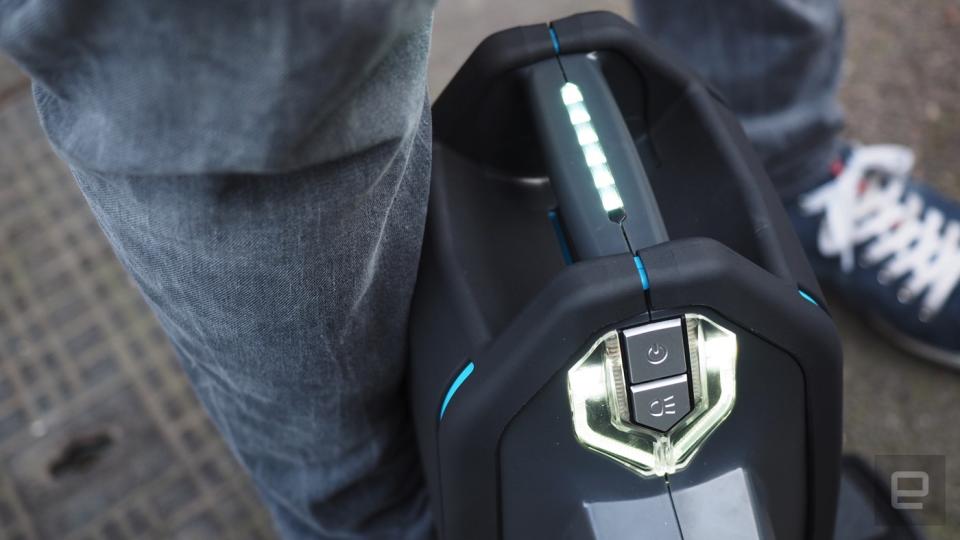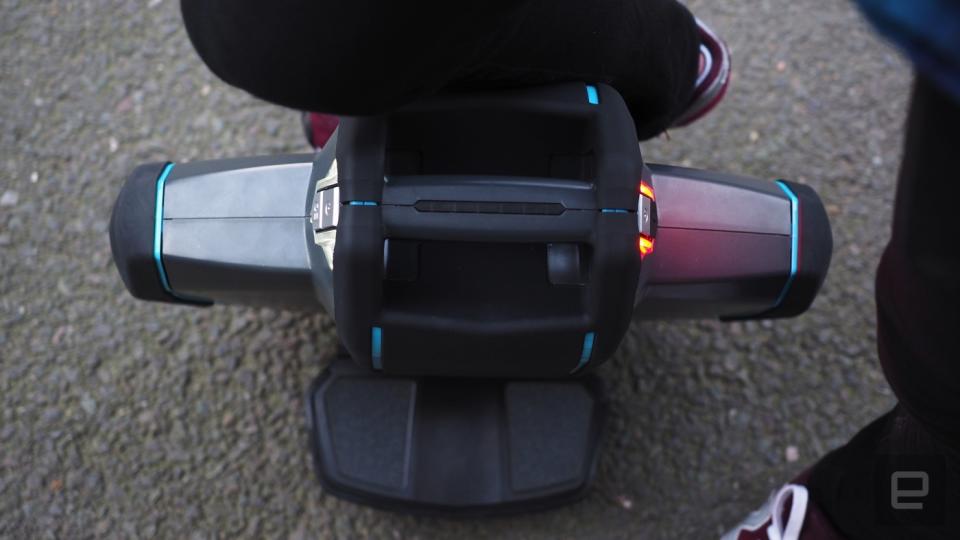I learned to ride an electric unicycle
It's even harder than it looks.

As a beginner, stepping onto an electric unicycle is equal parts frightening and exhilarating. There are no handlebars to grip or a saddle to clench between your thighs, just two narrow pedals separated by a small motorized wheel. Leaning forwards or backwards propels you in that direction, while tilting to either side, similar to a slalom skier, allows you to turn. These delicate bodily adjustments sound simple enough, but actually performing them on the Uniwheel, the first of its kind designed and engineered in the UK, is another matter entirely. You can fall off in an infinite number of ways and for the first few hours, you will. A lot.
I met the Uniwheel team in a gloomy warehouse buried inside London's Shoreditch district. A few bulbs shed some light on the contraption, which is wrapped in a combination of grey, navy and electric blue plastics. A sturdy handle is positioned on top and a single wheel peeks out below. Two thin pedals hug the sides before folding down to accommodate the rider's feet. Two large buttons are on the front -- one for power, one for the lights -- and pressing the former brings the 1500W motor to life.

Uniwheel's employees had created a small, rectangular area where I could practice with other journalists. Similar to an ice skating rink, it was a scene of comical carnage as inexperienced riders fell to the floor and clung desperately to their instructors. I was no different. The first half an hour was a heart-thumping blur as I learned to shuffle around with my left foot on the floor, and then ride in a circle with both feet on the pedals and my arm wrapped around another person's shoulder. Slowly, I began to find my balance and ride around unaided; first kicking off with one foot and scooting precariously in a straight line; and second, gliding around in a wobbly oval shape without bumping into my fellow learners.

Within an hour or two, it had all come together. Just outside the warehouse I was able to make small, nervous laps with a Cheshire Cat grin plastered across my face. The Uniwheel has a top speed of 20 km/h (12MPH), which is currently set by the software. It's capable of going faster though, and the company is developing a sort of "Sport" mode for owners that feel confident in their riding ability. For most people, the Uniwheel will be a recreational tool, but the company is also keen to position it as a serious form of transportation. The average rider should be able to get 11 km (6.8 miles) from a single battery pack. It can then be swapped out and, when convenient, charged from flat to full in roughly 90 minutes.
"You'll use it for enjoyment, but once you get used to it you'll naturally want to use it rather than a bus or the Tube," Uniwheel's design engineer Grant Fraser says. "With cycling, you can get everywhere but then you're sweaty at the end of it. With the Uniwheel, you never get sweaty."

Electric unicycles have existed for some time, but the company hopes to set itself apart with a design that's sleeker, smarter and safer than its competitors. Like a bicycle, there are safety lights on the front and back -- red on the rear for visibility and white on the front to show you what's up ahead. If you lean backwards and start moving in the opposite direction, however, the wheel will recognise this and automatically switch them around. There are also infrared sensors near the pedals that alert the device when the rider has stepped off. Handy, as it stops the wheel from racing off every time you fall or abruptly stop to avoid a pedestrian.
The Uniwheel comes with a companion app that pairs over Bluetooth and displays useful information such as your speed, range, and remaining charge. The range can be displayed as a circle on a map, making it easier to work out whether you have enough juice to reach the office or a friend's house. In addition, the team is working on a leaderboard system so that you can compete with friends and local riders. The company can also deploy software updates through the app so that, rather like one of Elon Musks's Teslas, new features can be added and refined remotely.

The wheel's main case is made from a plastic called Tritan, which the company claims is stronger than conventional polycarbonates. The Uniwheel is designed to be "as solid as possible" and the bumpers, which are most likely to pick up dents, can be replaced without any tools.
The battery packs can also be made safer by enabling a special "flight safe mode," taking out the fuse and covering the live terminals. So if you're carrying some spares in your bag, you shouldn't have to worry about them shorting or causing other problems. These details are crucial not just for the rider's personal safety, but for building a case that could potentially legalise the device in the UK. Self-balancing scooters, or "hoverboards," are currently banned from British roads and pavements. Electric unicycles fall under the same restrictions, although the team says they ride them to work every day and have never had any problems with the police.
"None of us have ever been arrested!"
The Uniwheel's design, build quality and safety features set it apart from the competition, but in exchange there's a steep sticker price. The "rideable" is available to pre-order for £990 ($1500); at that price, you need to be confident it'll be more than a brief novelty. I certainly had fun riding it, but I can't see myself using it as a full-time bicycle replacement. It's fast and fairly portable, but I wouldn't feel safe riding it down Oxford Street or a pavement packed with disgruntled commuters. A thrilling ride it most certainly is, but a practical transportation alternative? I'm not so sure.

